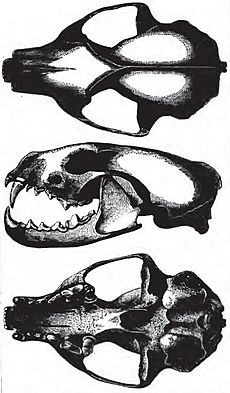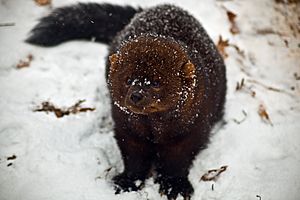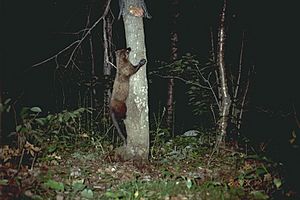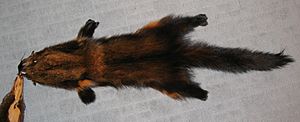Fisher (animal) facts for kids
Quick facts for kids Fisher (animal) |
|
|---|---|
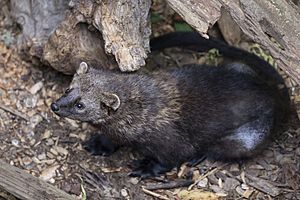 |
|
| At Mount Rainier National Park | |
| Conservation status | |
| Scientific classification | |
| Genus: |
Pekania
|
| Species: |
pennanti
|
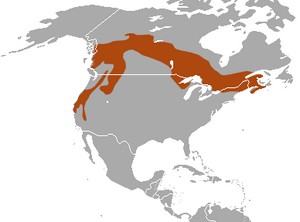 |
|
| Fisher range | |
| Synonyms | |
|
List
Mustela pennantii Erxleben, 1777
Mustela canadensis Schreber, 1788 Mustela melanorhyncha Boddaert, 1784 Mustela zibellina nigra Kerr, 1792 Viverra piscator Shaw, 1800 Viverra canadensis Shaw, 1800 Mustela nigra Turton, 1802 Mustela piscatoria Lesson, 1827 Martes pennantii Smith, 1843 Martes pennanti Coues, 1877 |
|
The fisher (Pekania pennanti) is a small, meat-eating mammal that lives in North America. It's a forest animal found in the cold boreal forests of Canada and the northern United States. The fisher belongs to the mustelid family, also known as the weasel family. It's the only species in its group, called Pekania.
The fisher is related to the American marten but is larger. In some places, people call the fisher a pekan, which comes from the Abenaki language. Another name is wejack, from an Algonquian word. Sometimes, people mistakenly call it a fisher cat, but it's not a cat at all!
Fishers don't have many natural enemies besides humans. People have trapped them for their fur since the 1700s. Their fur was so popular that fishers disappeared from many parts of the United States in the early 1900s. Thanks to conservation efforts, their numbers have grown back. However, they still don't live in all the places they used to. In the 1920s, when fur prices were high, some people tried to raise fishers on farms. But it was hard because of their unusual way of having babies. When fur prices dropped in the late 1940s, most fisher farms closed. Fishers usually stay away from people, but as humans build more in forest areas, there can be some conflicts.
Male and female fishers look alike. Adult males are about 90 to 120 cm (35 to 47 inches) long and weigh 3.5 to 6.0 kg (7.7 to 13.2 pounds). Females are smaller, about 75 to 95 cm (30 to 37 inches) long and weighing 2.0 to 2.5 kg (4.4 to 5.5 pounds). Their fur changes with the seasons, becoming thicker and shinier in winter.
Fishers prefer to hunt in dense forests. Even though they are good climbers, they spend most of their time on the ground. They like to search for food around fallen trees. Fishers are omnivores, meaning they eat both plants and animals. They eat many small animals and sometimes fruits and mushrooms. They especially like snowshoe hares. Fishers are also one of the few animals that can successfully hunt porcupines. Despite their name, they rarely eat fish!
The fisher's reproductive cycle lasts almost a year. Female fishers give birth to three or four babies, called kits, in the spring. They take care of their kits until late summer, when the young are old enough to live on their own. Soon after giving birth, the females are ready to mate again. The fertilized egg waits until the next spring to start growing, and then the cycle begins again.
Contents
What's in a Name?
Even though it's called a "fisher," this animal doesn't usually eat fish. The name actually comes from an old word, "fitch," which meant a European polecat or its fur. This is because the fisher looks a bit like a polecat. The name came from the Dutch word fisse or visse.
Fisher Family Tree
The scientific name for the fisher, pennanti, honors Thomas Pennant, who described the animal in 1771. Other scientists also gave it names, like Mustela canadensis. The fisher was later placed in the group Martes.
In 2008, scientists used advanced DNA tests to learn more about the fisher's history. They found that the fisher was unique enough to be put into its own group, or genus. So, they created the genus Pekania and renamed the fisher Pekania pennanti.
Fishers in the Pekania group have four premolar teeth on their upper and lower jaws. Their close relatives in the Mustela group have only three. Fishers have a total of 38 teeth.
How Fishers Evolved
Evidence shows that the ancestors of fishers came to North America millions of years ago. Fossils of older mustelids, like Pekania palaeosinensis, have been found in Asia. This suggests that fishers migrated from Asia to North America. The first true fisher, P. diluviana, has only been found in North America. Modern fishers, P. pennanti, have been around for at least 125,000 years and haven't changed much since then. Fossils also show that fishers used to live farther south than they do today.
Scientists once thought there were three different types, or subspecies, of fishers. However, later research showed that these types are very hard to tell apart based on their fur or skulls. So, today, most scientists agree that the fisher is just one species without different subspecies.
Fisher Life and Habits
Physical Features
Fishers are medium-sized mammals, similar in size to a house cat. They have long, thin bodies that are low to the ground. Males and females look alike, but males are much bigger. Males are about 90 to 120 cm (35 to 47 inches) long and weigh 3.5 to 6.0 kg (7.7 to 13.2 pounds). Females are 75 to 95 cm (30 to 37 inches) long and weigh 2.0 to 2.5 kg (4.4 to 5.5 pounds). The heaviest male fisher ever recorded weighed 9 kg (20 pounds)!
A fisher's fur changes with the seasons and is a bit different between males and females. Males have rougher coats. In early winter, their fur is thick and shiny, ranging from deep brown to black. It looks even blacker against white snow. From their face to their shoulders, their fur can look golden or silver because of special hairs. Their underside is mostly brown, with some random white or cream patches. In summer, their fur color can vary more and become lighter. Fishers shed their fur, or molt, from late summer until November or December.
Fishers have five toes on each foot, with claws that can be pulled back. Their feet are large, which helps them move easily on snow. They also have special coarse hairs between their pads and toes on their back feet. This gives them extra grip on slippery surfaces. Fishers have very flexible ankle joints that can rotate almost 180 degrees. This amazing ability allows them to climb down trees head-first! Not many mammals can do that.
On the central pad of their back paws, fishers have a special patch of hair with glands that produce a unique smell. These patches get bigger during mating season, so they probably help fishers leave scent trails to find each other for mating.
Hunting and Diet
Fishers are generalist predators, meaning they eat many different things. Their main prey are snowshoe hares and porcupines. They also eat insects, nuts, berries, and mushrooms. Since they hunt alone, their prey choices are limited by their size. Scientists have studied what fishers eat by looking at their stomach contents and droppings. They've found evidence of birds, small mammals, and even deer, which means fishers will also eat dead animals.
While it's not common, fishers have been known to hunt larger animals like wild turkeys, bobcats, and Canada lynx. In Maine, researchers found several cases where fishers hunted lynx. The fishers would attack lynx resting in snowstorms, biting their necks quickly and powerfully. There would be some struggle, but the fishers usually finished the lynx off fast.
Fishers are one of the few predators that actively hunt and kill porcupines. Some old stories say that fishers can flip a porcupine on its back and "scoop out its belly." But this is not true. Studies show that fishers make repeated bites to the porcupine's face, killing it after about 25–30 minutes.
Reproduction and Life Cycle
Female fishers start having babies when they are about one year old. Their reproductive cycle lasts almost a full year. Mating happens in late March to early April. After mating, the fertilized egg doesn't start growing right away. It waits for about ten months until mid-February of the next year. This is called delayed implantation. After about 50 days of active pregnancy, the female gives birth to one to four kits. Then, just 7–10 days later, the female is ready to mate again, and the cycle restarts.
Female fishers make their dens in hollow trees. When kits are born, they are blind, helpless, and have fine hair. They start to crawl after about three weeks and open their eyes after about seven weeks. They begin to climb after eight weeks. For the first 8 to 10 weeks, kits drink only their mother's milk. After that, they start eating solid food. When they are about four months old, they don't get along with their litter mates as well. At five months, their mother encourages them to leave and live on their own. By the time they are one year old, young fishers will have found their own hunting areas.
Social Life and Home Range
Fishers are usually most active around dawn and dusk, and sometimes at night. They are active all year round. Fishers are solitary animals, meaning they live alone and only meet other fishers to mate. Males become more active during mating season. Females are least active when they are pregnant and slowly become more active after their kits are born.
A fisher's hunting area, or home range, can vary in size. It might be about 6.6 square kilometers (2.5 square miles) in the summer and up to 14.1 square kilometers (5.4 square miles) in the winter. Some winter ranges can be as large as 20.0 square kilometers (7.7 square miles), depending on how good the habitat is. Male and female fishers can have overlapping territories. Males often have larger territories that overlap with several females.
Fisher Health
Fishers can get parasites, which are tiny organisms that live on or inside another animal. Some of these include different types of worms, like roundworms and tapeworms.
Where Fishers Live
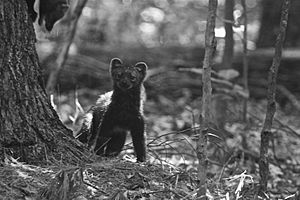
Even though fishers are good at climbing trees, they spend most of their time on the forest floor. They prefer forests with lots of trees that provide continuous cover. They can be found in thick conifer forests, like those in the boreal region, but also in forests with a mix of hardwood and conifer trees. Fishers like areas where more than 80% of the ground is covered by trees overhead. They avoid areas with less than 50% cover. Fishers are more likely to be found in old-growth forests. Since female fishers need moderately large trees for their dens, forests that have been heavily cut down and have a lot of new, small trees might not be suitable for them.
Fishers also like forest floors with a lot of fallen trees and branches. In western forests, where fires often clear out undergrowth, fishers prefer areas near rivers and streams. Fishers tend to avoid places with deep snow. The type of habitat they choose is also affected by how packed down the snow is and how much moisture is in it.
Where to Find Fishers
Fishers are found across the northern forests of North America. Their range stretches across Canada, from Nova Scotia in the east to British Columbia in the west, and north to Alaska. They can be found as far north as Great Slave Lake in the Northwest Territories and as far south as the mountains of Oregon. You can also find smaller groups of fishers in the Sierra Nevada mountains of California, throughout New England, and in the Appalachian Mountains in states like Pennsylvania and West Virginia.
In the late 1800s and early 1900s, fishers almost disappeared from the southern and eastern parts of their range, including many American states and eastern Canada. This happened because of too much trapping and the loss of their forest homes.
By the 1930s, most states had put limits on fisher trapping. At the same time, forests started growing back on old farmlands, and better forest management helped create more habitat. This allowed the remaining fisher populations to recover. Their numbers have grown enough that they are no longer endangered. With more forest cover in eastern North America, fisher populations should stay strong for the future.
In some areas where fishers had disappeared, the number of porcupines increased a lot. These high porcupine numbers caused a lot of damage to trees. To fix this, fishers were brought back to these areas from other places. Once the fishers were re-established, the porcupine numbers went back to normal levels.
Today, scattered fisher populations exist in the Pacific Northwest. Fishers have been reintroduced to places like Oregon and Washington State. These reintroduced animals are watched using radio collars and cameras, and they have been successfully having babies. In California, fishers are considered a threatened species under the Endangered Species Act of 1973.
Recent studies show that fishers are now moving into suburban areas, farmlands, and towns in several US states and eastern Canada. You can find them as far south as northern Massachusetts, New York, Connecticut, and even northwestern New Jersey. They had almost disappeared from Cape Cod after the Cape Cod Canal was built, but some reports show that populations are coming back there too, though they are likely smaller than in other parts of New England.
Fishers and People
Fishers have had a long history with humans, but often it has been bad for fisher populations. It's very rare for a fisher to attack a human without being provoked. However, they will attack if they feel threatened or trapped. There have been a few rare cases where fishers were blamed for attacking children.
Fur Trade and Conservation
People have trapped fishers for their fur since the 1700s. Their fur was very valuable and used for things like scarves. The best furs come from winter trapping. Fishers are easy to trap, and the high value of their fur made people want to catch them.
Prices for fisher furs have changed a lot over the years. They were highest in the 1920s and 1930s. In 1936, some furs were sold for $450–750 each! Prices went down until the 1960s but rose again in the late 1970s. In 1979, one female pelt sold for $410.
Between 1900 and 1940, fishers were almost wiped out in the southern parts of their range because of too much trapping and changes to their habitat. In New England, most fur-bearing animals, including fishers, were nearly gone due to unregulated trapping. Fishers disappeared from many northern U.S. states after 1930. However, there were still enough in Canada to keep trapping them. Some protection was given in the early 1900s, but full protection for the few remaining fishers didn't happen until 1934. Thanks to closed hunting seasons, habitat recovery, and reintroducing fishers to new areas, they have returned to much of their original range.
Trapping started again in the U.S. after 1962, once their numbers had recovered. In the early 1970s, the value of fisher furs went up again, leading to another drop in their population in 1976. After a few years of no trapping, it reopened in 1979 with shorter seasons and limits on how many could be caught. Since then, the population has steadily grown, even though fur prices are much lower now.
Fishers in Zoos and Research
Fishers have been caught alive for fur farms, zoos, and scientific studies. From 1920–1946, fur prices were high, so people tried to raise fishers on farms, like they did with mink. But farmers found it hard to raise fishers because of their unusual reproductive cycle. They didn't know about the delayed implantation at the time. Farmers noticed that females mated in the spring but didn't give birth. Because fur prices dropped, most fisher farms closed by the late 1940s.
Zoos have also captured and bred fishers, but they are not a common zoo animal. Fishers often hide from visitors all day, making them difficult to display. Some zoos have had trouble keeping fishers alive because they can get many diseases in captivity. However, at least one fisher lived to be 10 years old in captivity, and another lived to be about 14 years old, which is much longer than their natural lifespan of about 7 years.
In 1974, a scientist named R.A. Powell raised two fisher kits for research. He wanted to measure how active fishers were to figure out how much food they needed. He made them run on treadmills to simulate their activity in the wild. He compared this to how much they ate to estimate their daily food needs. This research lasted two years. One fisher died, but the other was released back into the wild in Michigan.
Fishers and Pets
In some areas, fishers can become a problem for farmers if they raid chicken coops. There have also been reports of fishers hunting cats and small dogs. However, a 1979 study looked at the stomach contents of over 1,000 fishers trapped in New Hampshire and found cat hairs in only one of them. Another study in upstate New York found no cat remains in 24 samples, and an earlier study in Massachusetts found no cat in 226 samples. This suggests that while it can happen, fishers rarely prey on domestic cats.
Fishers in Stories
Fishers have appeared in books. In The Audubon Book of True Nature Stories, Robert Snyder tells about seeing fishers in the Adirondack Mountains of New York, including one attacking a porcupine.
In Winter of the Fisher, Cameron Langford writes a fictional story about a fisher and an old man living alone in the forest. The man frees the fisher from a trap and helps it get better. The fisher tolerates the man's care but, being a wild animal, returns to the forest when it's well. Langford uses facts about fishers to create a story about survival in the northern Canadian woods.
Fishers are also mentioned in other books, like The Blood Jaguar (where a fisher is an animal shaman) and Ereth's Birthday (where a fisher hunts porcupines). They are also mentioned in The Sign of the Beaver, where a fisher is thought to have been caught in a trap.
Images for kids
See also
 In Spanish: Pekán para niños
In Spanish: Pekán para niños



